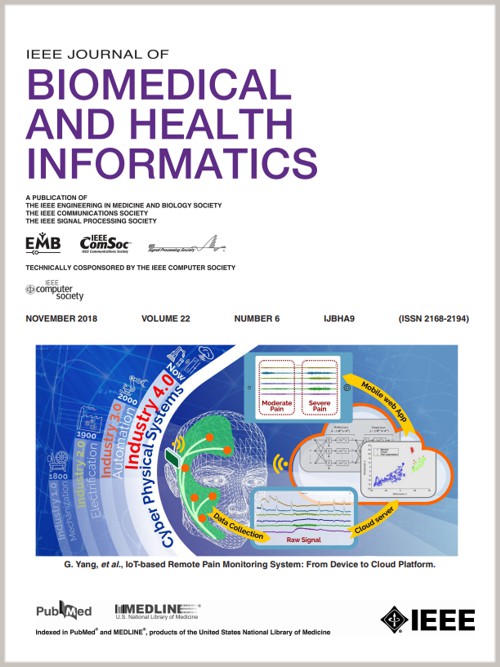Camera-Based Seismocardiogram for Heart Rate Variability Monitoring
IF 6.8
2区 医学
Q1 COMPUTER SCIENCE, INFORMATION SYSTEMS
IEEE Journal of Biomedical and Health Informatics
Pub Date : 2024-02-27
DOI:10.1109/JBHI.2024.3370394
引用次数: 0
Abstract
Heart rate variability (HRV) is a crucial metric that quantifies the variation between consecutive heartbeats, serving as a significant indicator of autonomic nervous system (ANS) activity. It has found widespread applications in clinical diagnosis, treatment, and prevention of cardiovascular diseases. In this study, we proposed an optical model for defocused speckle imaging, to simultaneously incorporate out-of-plane translation and rotation-induced motion for highly-sensitive non-contact seismocardiogram (SCG) measurement. Using electrocardiogram (ECG) signals as the gold standard, we evaluated the performance of photoplethysmogram (PPG) signals and speckle-based SCG signals in assessing HRV. The results indicated that the HRV parameters measured from SCG signals extracted from laser speckle videos showed higher consistency with the results obtained from the ECG signals compared to PPG signals. Additionally, we confirmed that even when clothing obstructed the measurement site, the efficacy of SCG signals extracted from the motion of laser speckle patterns persisted in assessing the HRV levels. This demonstrates the robustness of camera-based non-contact SCG in monitoring HRV, highlighting its potential as a reliable, non-contact alternative to traditional contact-PPG sensors.基于摄像头的地震心动图,用于心率变异性监测。
心率变异性(HRV)是量化连续心跳之间变化的重要指标,是自律神经系统(ANS)活动的重要指标。它已广泛应用于心血管疾病的临床诊断、治疗和预防。在这项研究中,我们提出了一种用于散焦斑点成像的光学模型,以同时结合平面外平移和旋转引起的运动,进行高灵敏度的非接触式地震心动图(SCG)测量。以心电图(ECG)信号作为金标准,我们评估了光电血压计(PPG)信号和基于斑点的 SCG 信号在评估心率变异方面的性能。结果表明,与 PPG 信号相比,从激光斑点视频中提取的 SCG 信号测得的心率变异参数与心电图信号测得的结果具有更高的一致性。此外,我们还证实,即使衣物遮挡了测量部位,从激光斑点图案运动中提取的 SCG 信号仍能有效评估心率变异水平。这证明了基于摄像头的非接触式 SCG 在监测心率变异方面的稳健性,凸显了其作为传统接触式 PPG 传感器的可靠、非接触式替代品的潜力。
本文章由计算机程序翻译,如有差异,请以英文原文为准。
求助全文
约1分钟内获得全文
求助全文
来源期刊

IEEE Journal of Biomedical and Health Informatics
COMPUTER SCIENCE, INFORMATION SYSTEMS-COMPUTER SCIENCE, INTERDISCIPLINARY APPLICATIONS
CiteScore
13.60
自引率
6.50%
发文量
1151
期刊介绍:
IEEE Journal of Biomedical and Health Informatics publishes original papers presenting recent advances where information and communication technologies intersect with health, healthcare, life sciences, and biomedicine. Topics include acquisition, transmission, storage, retrieval, management, and analysis of biomedical and health information. The journal covers applications of information technologies in healthcare, patient monitoring, preventive care, early disease diagnosis, therapy discovery, and personalized treatment protocols. It explores electronic medical and health records, clinical information systems, decision support systems, medical and biological imaging informatics, wearable systems, body area/sensor networks, and more. Integration-related topics like interoperability, evidence-based medicine, and secure patient data are also addressed.
 求助内容:
求助内容: 应助结果提醒方式:
应助结果提醒方式:


